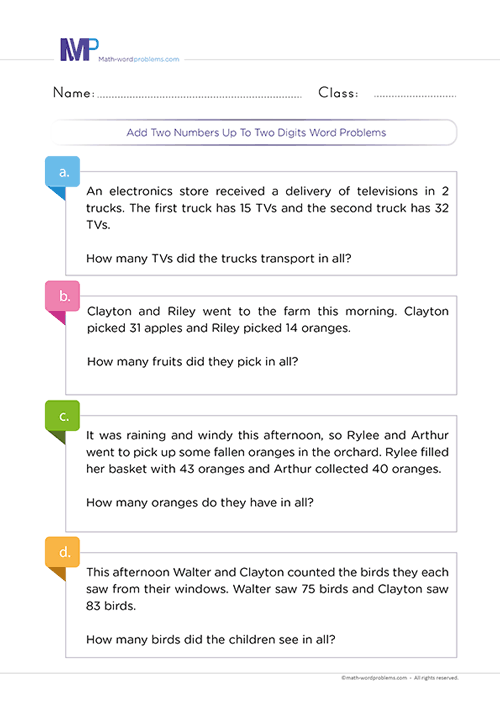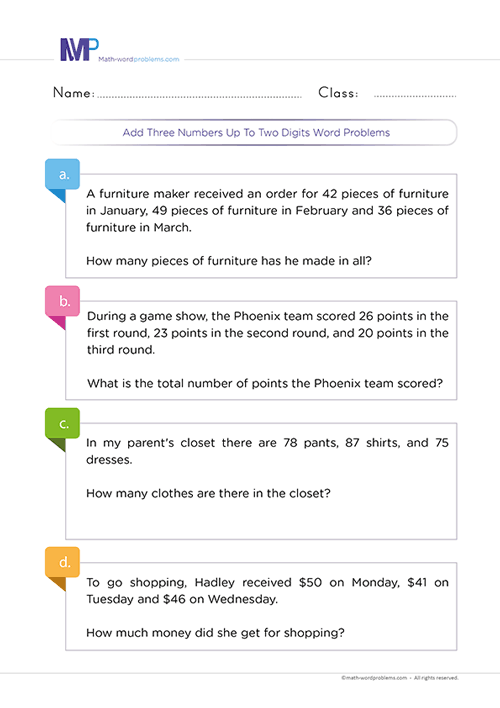 How to form addition sentence word problems with sums up to 20
How to form addition sentence word problems with sums up to 20

- INTRODUCTION
- Step 1 Identify
- Step 2 STRATEGIZE
- Step 3 SET UP
- Step 4 PROVIDE A SOLUTION
- Step 5 CHECK YOUR WORK
Get more contents on this skill...
Learning how to form addition sentence word problems with sums up to 20 is the trickiest topic in grade 2. However, our outstanding resource is here to provide 2nd Graders with simple tips to form addition sentence word problems. In addition, we will provide a schematic approach to tackle simple and challenging word problems. Thus, a significant way to facilitate and enhance your kids’ addition word problems solving skills.
Another fun and remarkable way to uplift kids’ skills in this unique resource is by designing correct schematic drawings. Kids can insert numbers from the problem into this drawing for a given category effortlessly.
Steps to solve addition sentence word problems with sums up to 20
Below are the steps to solve addition sentence word problems with sums up to 20. As mentioned earlier, these steps will enable kids with learning disabilities to represent any complex addition sentence word problem with concrete objects using a schematic diagram. Hence, use these objects to carry out the solution to the problem accurately. how to add four or more one-digit with sums up to 50 numbers word problems.
Also, kids will know how to use a sophisticated counting strategy using the schematic diagram derived directly from the representation of the problem situation.
For learners to ultimately understand how to form addition sentence word problems with sums up to 20, the following real-world situation examples will show how fantastic and quick these unique steps work.
Step 1 IDENTIFY THE PROBLEM
To identify the problem,
- First, you must read the problem out loud to yourself to know what the problem is asking,
- Then, identify and underline statements that are related,
- Kids should read the problem out loud because it enables them to say and hear the question. Hence, a better way to form a clearer picture of the problem in their head and prepare them to solve it;
Step 2 DRAW A VISUAL REPRESENTATION OF THE PROBLEM
2nd Graders need to visualize a problem to understand it. As they get to advanced grades, they can start to have a mental representation of the problem in their heads. But at this young age, they should draw a picture explaining what the problem is all about.
i.e., draw a schematic diagram of the problem that will:
- Match the representation to the problem,
- Accurately translate quantitative detail from the problem to a constructed diagram,
- Correctly identify critical points pertinent to solving the problem;
Step 3 DETERMINE THE KEYWORDS
Every word problem has keywords to look out for that tell you what operation to do. As kids practice word problems frequently, finding the keywords will get easier.
When it comes to addition sentences word problems with sums up to 20, these are the keywords that you’ll find:- add, plus, more, total, increase, together/all together, combined, sum, grow, join, both, in all, altogether, how many in all, how much, and, etc.
Note: learners should understand that it would be best not to rely entirely on keywords alone because a particular keyword can have different meanings in different word problems.
So, it is essential to read the question very well to understand the situation that the word problem is describing, then figure out if the problem makes sense before proceeding to find which operation you will use.
Step 4 STRATEGIZE AND DETERMINE THE OPERATIONS
Now, ask yourself, “What do I need to find in this problem?”
As you know, some word problems are straightforward, but you have to think very well with some.
In this step, you will apply the read-to-understand rule, i.e., you must read the word problem and try to interpret it in your own words.
In addition, since each word problem may require a different solving method, the key points below will enable young math learners to tackle any word problem irrespective of the way the problem is.
- First, the keyword(s) in the word problem will help clarify the operation you need to carry out.
- However, as mentioned above, using keywords alone to solve word problems has some limits.
- So, you must first read the word problem to understand the situation that the problem is describing.
- Reading the problem to understand it will enable you to identify the problem type and relational statement, which, together with the keyword(s) in the problem, will determine the accurate math operation you need.
Step 5 LIST WHAT IS GIVEN
At this point, you should list what you know. Trying to solve the problem without knowing what tools to use will not give an accurate result. For this reason, you need to know all the facts by doing the following:
- Now, after knowing which operation you will perform from step 2 above, form short phrases to represent the information given in the word problem,
- These short phrases or sentences represent the vital information in the schematic diagram, making it easier to solve the word problem,
- Then, deduce a solvable maths equation with the aid of the schematic diagram to represent the information in the phrases you constructed above;
Step 6 SET UP A MATHEMATICAL EQUATION
Here, with the aid of the schematic diagram that you drew in step 2, you will deduce a numerical expression/ mathematical equation that portrays the information given in the word problem (precisely in step 5)
Step 7 SOLVE THE PROBLEM
After writing down the maths equation, you can solve the problem using any addition method of your choice, preferably the column method. Furthermore, always include the unit of measurement in the final result.
OR
When dealing with one-digit word problems involving addition, you can count all the symbols in your schematic diagram, and the total will equal the final answer.
Step 8 VERIFY YOUR ANSWER
Finally, check your work to ensure your answer fits the problem asked.
For instance, mathematically, you can check your work by doing the opposite of whatever operation you used in solving the problem asked.




